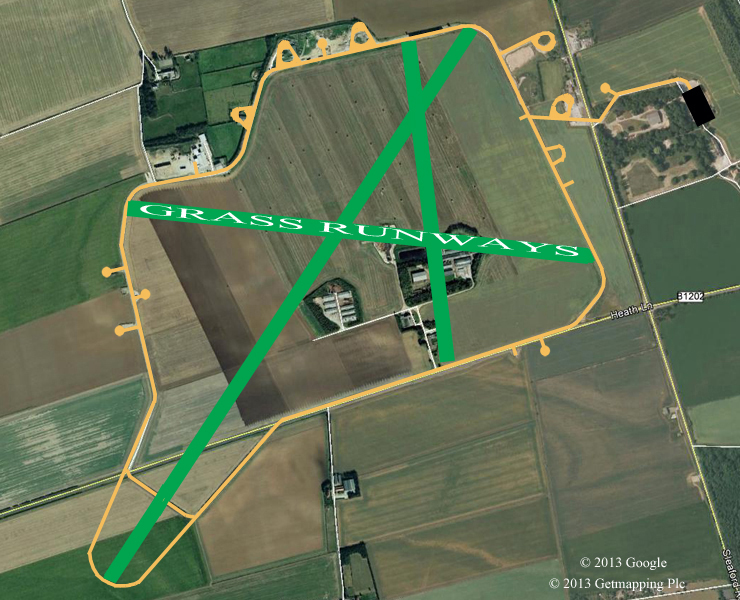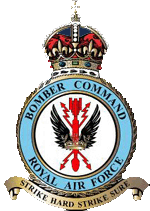Coleby Grange Airfield History

(Map edited to show the airfield and runways between 1940-45)

© Crown Copyright/MOD 2010
53° 7'56.53"N 0°30'2.13"WRunways:
NE/SW 6000ft (grass) - NW/SE 4200ft (grass) - N/S 2898ft (grass)
Coleby Grange opened in 1939 with a single grass runway as a relief landing ground for RAF Cranwell, with No.253 Squadron and No.264 Squadron starting to use it. In May 1941 the airfield was transferred to 12 Group, Fighter Command and became a satellite to RAF Digby. With No.402 Squadron then moving in. No.409 Squadron RCAF were present at Coleby from July 1941 to February 1943 and again from December 1943 to February 1944. No.410 Squadron RCAF filled the gap from February to October 1943 on night fighter defence duties. The station was also home to No.307 (Polish) Squadron, with them departing Coleby in May 1945.
A concrete perimeter track encircled the airfield, part of which used the B1202 road which formed the southern boundary of the station. The airfield was ultimately equipped with nine hangars, one T1, one blister and seven extended over-blisters and accommodation was provided for 1800 personal, RAF and WAAF's, all ranks.
Once German daylight raids had stopped in 1943, RAF Kirton in Lindsey became a training unit and RAF Hibaldstow was closed. RAF Digby took on a non-operational role involved in radar calibration and other duties. This left Coleby Grange standing alone to combat the threat of night raids in Lincolnshire.
Both No.425 Squadron and the USAF 9th Air Force deployed from Coleby Grange to participate in the Allied Expeditionary Air Force effort during Operation OVERLORD/NEPTUNE in Normandy, June 1944. The station closed and placed on care and maintenance just before the end of the war in May 1945. After WWII, Coleby was a transit station and in autumn 1945, transferred to 27 Group as a satellite of No.17 Service Flying Training School.
1959 saw Coleby Grange re-opened with No.142 (SM) Squadron. The Thor IRBM unit had 3 launchers. Each missile was armed with a one-megaton nuclear warhead, which was controlled by the US Air Force under the so called dual-key arrangements. RAF Hemswell was the headquarters for the 5 Lincolnshire dispersal sites at RAF Hemswell, RAF Bardney, RAF Caistor, RAF Coleby Grange and RAF Ludford Magna. The station was closed for the final time in 1963.
Today Coleby Grange is in private hands and used for agriculture. The Dunston Land Pillar, which can be seen to the north-east of the airfield on the East side of the A15, was reduced in height by 40ft and had its lantern removed during WII due to it being a hazard for aircraft in the Coleby circuit. The land pillar had originally been built by Dashwood to lead travellers across the difficult to navigate Lincoln Heath after it had been reclaimed from heath and scrubland. All that remains is the Control Tower, which still stands although in a ruined state, as a visible sign of the station's existence.
| Date | Squadron | Notes |
|---|---|---|
| 1939 | Station opened. | |
| July 1940 | No.253 Sqn | Operating the Hawker Hurricane. The squadron left the airfield on the 9th July 1940. |
| August 1940 | No.264 Sqn | Operating the Boulton Paul Defiant. The squadron left the station on the 21st August 1940. |
| July 1941 | No.409 (RCAF) Sqn | Operating the Boulton Paul Defiant, Bristol Beaufighter. The squadron left Coleby on the 27th February 1943. |
| February 1943 | No.410 (RCAF) Sqn | Operating the de Havilland Mosquito. The squadron left the station on the 21st October 1943. |
| November 1943 | No.288 Sqn | Operating the Airspeed Oxford, Boulton Paul Defiant, Lockheed Hudson. The squadron left the airfield on the 25th November 1943. |
| November 1943 | No.264 Sqn | Operating the de Havilland Mosquito. The squadron left Coleby on the 18th December 1943. |
| February 1944 | No.68 Sqn | Operating the Bristol Beaufighter. The squadron left station on the 3rd March 1944. |
| March 1944 | No.307 (Polish) Sqn | Operating the de Havilland Mosquito. The squadron left the airfield on the 4th May 1944. |
| November 1944 | No.17 SFTS | Operating the Airspeed Oxford, North American Harvard. The Service Flying Training School left the airfield on the 11th November 1946. |
| February 1945 | No.1515 BAT Flt | Operating the Airspeed Oxford. The Beam Approach Training Flight left the station on the 1st June 1945. |
| April 1945 | No.107 EGS | Operating the T.31 Cadet. The Elementary Gliding School left Coleby in 1947. |
| April 1945 | Station closed and placed on Care and Maintenance. | |
| 1958 | Station re-opened. | |
| July 1959 | No.142 (SM) Sqn | The Thor IRBM Unit disbanded at the station on the 24th May 1963. |
| June 1963 | RAF Coleby Grange closed. | |
| 1964-5 | RAF Coleby Grange sold-off. |
